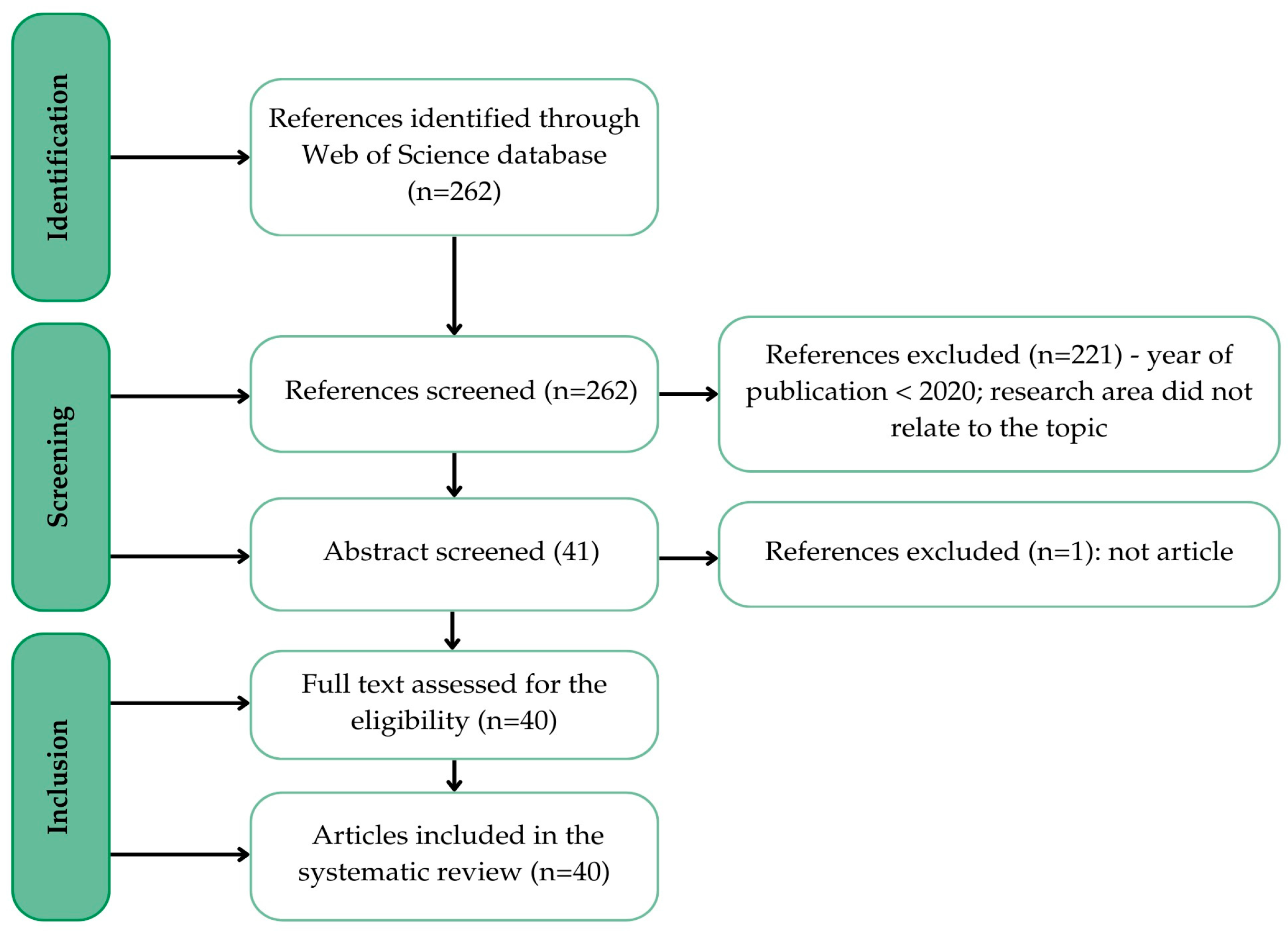Consumer Perceptions in the Alternative Fuel Vehicle Market: A Systematic Literature Review and Bibliometric Analysis †
Abstract
1. Introduction
- RQ1: What are the most frequently used keywords in the literature on the acceptance of AFVs?
- RQ2: What are the most common relationships between keywords in the literature on AFVs?
- RQ3: What dominant themes and clusters emerge in the literature on AFVs?
2. Materials and Methods
3. Results and Discussion of Bibliometric Analysis
4. Conclusions
4.1. Conclusions from the Bibliometric Analysis
4.2. Research Limitations and Directions
Funding
Institutional Review Board Statement
Informed Consent Statement
Data Availability Statement
Conflicts of Interest
References
- European Commission. Climate Action—Reducing Emissions from Transport. 2017. Available online: https://climate.ec.europa.eu/eu-action/transport_en (accessed on 15 June 2024).
- IEA. CO2 Emissions from Fuel Combustion (Statistics). International Energy Agency. 2017. Available online: https://www.iea.org/search?q=IEA.%20CO2%20Emissions%20from%20Fuel%20Combustion%20(Statistics).%20International%20Energy%20Agency.%202017 (accessed on 2 May 2024).
- Huang, Y.L.; Qian, L.X. Consumer adoption of electric vehicles in alternative business models. Energy Policy 2021, 155, 112338. [Google Scholar] [CrossRef]
- Carier, M. Electric Vehicle Consumers Worldwide—Statistics & Facts. 2023. Available online: https://www.statista.com/topics/9971/electric-vehicle-consumers-worldwide/#topicOverview (accessed on 7 June 2024).
- Buics, L.; Süle, E.; Szalay, M. Sustainability of On-Demand Public Transportation from the Customer Perspective. Chem. Eng. Trans. 2023, 107, 427–432. [Google Scholar]
- Dutta, B.; Hwang, H.G. Consumers purchase intentions of green electric vehicles: The influence of consumers technological and environmental considerations. Sustainability 2021, 13, 12025. [Google Scholar] [CrossRef]
- Sousa, N.; Almeida, A.; Coutinho-Rodrigues, J. A multicriteria methodology for estimating consumer acceptance of alternative powertrain technologies. Transp. Policy 2020, 85, 18–32. [Google Scholar] [CrossRef]
- Sargolzaei, S. Developing Technology Acceptance Models for Decision Making in Urban Management. MedCrave Group 2017, 2, 180–182. [Google Scholar] [CrossRef][Green Version]
- Abdelkafi, N.; Makhotin, S.; Posselt, T. Business model innovations for electric mobility—What can be learned from existing business model patterns? Imperial Coll. Press 2013, 17, 1340003. [Google Scholar] [CrossRef]
- Venkatesh, J.; Morris, M.E.; Davis, G.B.; Davis, F.D. User Acceptance of Information Technology: Toward a Unified View. MIS Q. 2003, 27, 425–478. [Google Scholar] [CrossRef]
- Rahimi, R.A. A Survey of Technology Acceptance Models in the Creative Industry: Exploring Key Limitations. In Proceedings of the 2020 13th International Conference on Developments in eSystems Engineering (DeSE), New York, NY, USA, 9–14 December 2020; IEEE: Piscataway, NJ, USA, 2020; pp. 9–14. [Google Scholar] [CrossRef]
- Buics, L.; Balassa, E.B. Analyzing Public Service Processes from Customer and Employee Perspectives by Using Service Blueprinting and Business Process Modelling. In Proceedings of the Entrenova: Enterprise Research Innovation Conference, Online, 22 September 2020; Volume 6, pp. 195–211. [Google Scholar]
- Teo, T.; Noyes, J. Explaining the intention to use technology among pre-service teachers: A multi-group analysis of the Unified Theory of Acceptance and Use of Technology. Interact. Learn. Environ. 2012, 22, 51–66. [Google Scholar] [CrossRef]
- Nagy, S.; Somosi, M.V. The relationship between social innovation and digital economy and society. Reg. Stat. 2022, 12, 3–29. [Google Scholar] [CrossRef]
- Page, M.J.; McKenzie, J.E.; Bossuyt, P.M.; Boutron, I.; Hoffmann, T.C.; Mulrow, C.D.; Shamseer, L.; Tetzlaff, J.M.; Akl, E.A.; Brennan, S.E.; et al. PRISMA 2020 explanation and elaboration: Updated guidance and exemplars for reporting systematic reviews. BMJ 2021, 372, n160. [Google Scholar] [CrossRef] [PubMed]
- Liberati, A.; Altman, D.G.; Tetzlaff, J.; Mulrow, C.; Gøtzsche, P.C.; Ioannidis, J.P.A.; Clarke, M.; Devereaux, P.J.; Kleijnen, J.; Moher, D. The PRISMA Statement for Reporting Systematic Reviews and Meta-Analyses of Studies That Evaluate Health Care Interventions: Explanation and Elaboration. Ann. Int. Med. 2009, 151, 65–94. [Google Scholar] [CrossRef] [PubMed]
- Moher, D.; Liberati, A.; Tetzlaff, J.; Altman, D.G. Preferred Reporting Items for Systematic Reviews and Meta-Analyses: The PRISMA Statement. PLoS Med. 2009, 6, e1000097. [Google Scholar] [CrossRef] [PubMed]
- Lam, S.Y.; Chiang, J.; Parasuraman, A. The effects of the dimensions of technology readiness on technology acceptance: An empirical analysis. J. Interact. Mark. 2008, 22, 19–39. [Google Scholar] [CrossRef]



Disclaimer/Publisher’s Note: The statements, opinions and data contained in all publications are solely those of the individual author(s) and contributor(s) and not of MDPI and/or the editor(s). MDPI and/or the editor(s) disclaim responsibility for any injury to people or property resulting from any ideas, methods, instructions or products referred to in the content. |
© 2024 by the author. Licensee MDPI, Basel, Switzerland. This article is an open access article distributed under the terms and conditions of the Creative Commons Attribution (CC BY) license (https://creativecommons.org/licenses/by/4.0/).
Share and Cite
Nagy, N.G. Consumer Perceptions in the Alternative Fuel Vehicle Market: A Systematic Literature Review and Bibliometric Analysis. Eng. Proc. 2024, 79, 41. https://doi.org/10.3390/engproc2024079041
Nagy NG. Consumer Perceptions in the Alternative Fuel Vehicle Market: A Systematic Literature Review and Bibliometric Analysis. Engineering Proceedings. 2024; 79(1):41. https://doi.org/10.3390/engproc2024079041
Chicago/Turabian StyleNagy, Nikolett Gyurián. 2024. "Consumer Perceptions in the Alternative Fuel Vehicle Market: A Systematic Literature Review and Bibliometric Analysis" Engineering Proceedings 79, no. 1: 41. https://doi.org/10.3390/engproc2024079041
APA StyleNagy, N. G. (2024). Consumer Perceptions in the Alternative Fuel Vehicle Market: A Systematic Literature Review and Bibliometric Analysis. Engineering Proceedings, 79(1), 41. https://doi.org/10.3390/engproc2024079041





